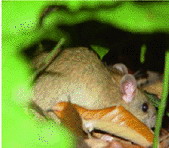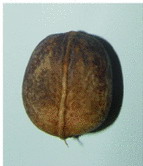The seed–rodent system is an ideal model for studying the mutualism–predation association and coexistence between plants and animals in forests. Rodents not only eat seeds but also disperse them and thus facilitate the seed regeneration of forests. Seeds and rodents have formed a very complex mutualism and predation relationship.
Pittosporopsis kerrii is the dominant shrub species in the tropical rainforest of Xihuangbanna region. It is also commonly seen in the tropical montane evergreen broad-leaved forest. Its seeds germinate very quickly after falling to the ground, usually within about 1 week. The nutritional component of germinated seeds gradually transformed into a dormant taproot, which is indigestible to rodents. It possessed a few traits to better escape from rodent predation.
Dr. Cao Lin, a postdoc of Xishuangbanna Tropical Botanical Garden (XTBG), and his supervisors investigated seed fates of intact seeds, pruned roots and pruned seeds of P. kerrii by rodents in the Menglun Nature Reserve, Xishuangbanna tropical forests, Yunnan Province, China. The study aimed to test two hypotheses: (1) seed pruning may be used by rodents to increase storage time by delaying the seed germination process of the non-dormant seeds of P. kerrii, and (2) a high regeneration capacity of severed seeds may be an important strategy for P. kerrii to escape seed predation by rodents.
The study found that rodents adopted a root-pruning strategy to extend the storage time of seeds. The researchers also found that such traits as rapid germination, seed decomposition, dormant taproots, and high regeneration capacity of pruned roots, pruned seeds or even embryo-removed seeds were possessed by the non-dormant seeds of P. kerrii that allowed seeds to better escape seed predation by rodents.
The anti-predation traits of P. kerrii Craib seeds may be the result of evolutionary adaptation to the intensive seminal root pruning and seed predation of germinated seeds by rodents. The high regeneration capacity of plant seeds is a very successful strategy to balance the effect of predation and dispersal on seed survival, and thus promotes mutualism as well as species coexistence between seeds and rodents in the tropical forests.


rodent and intact seed (Image by CAO Lin)
The study entitled “High regeneration capacity helps tropical seeds to counter rodent predation” has been published in Oecologia, 166(4):997-1007. DOI:10.1007/s00442-011-1908-1
Abstract http://www.springerlink.com/content/d7770701tq262886/


